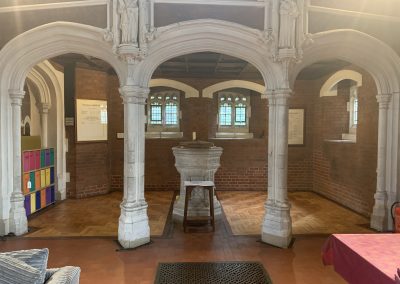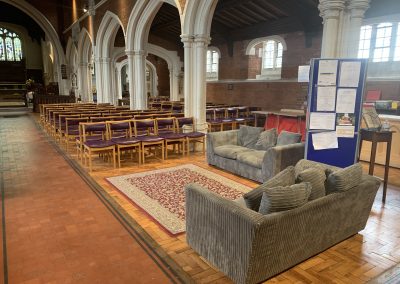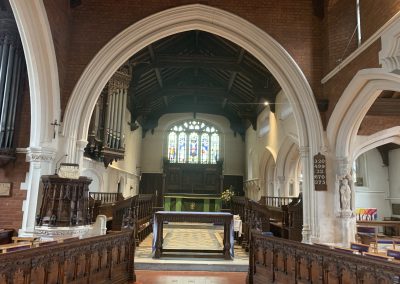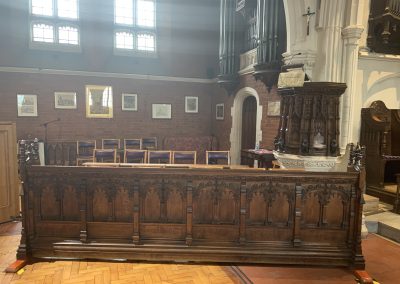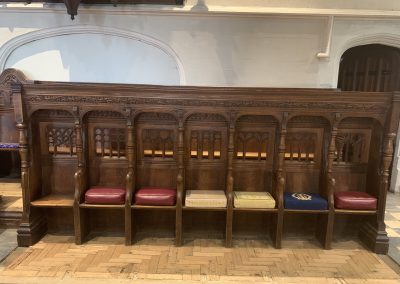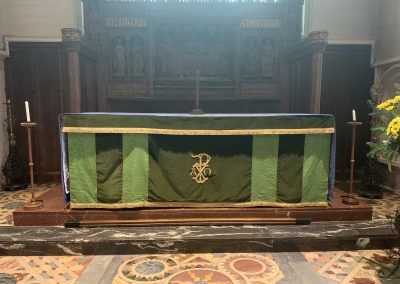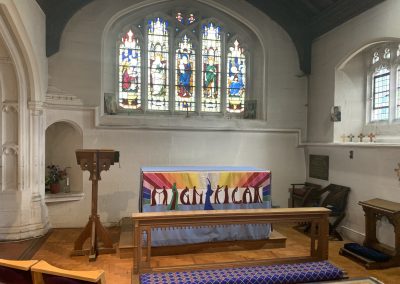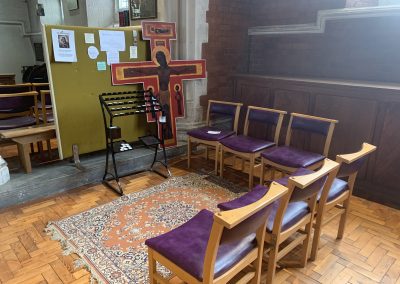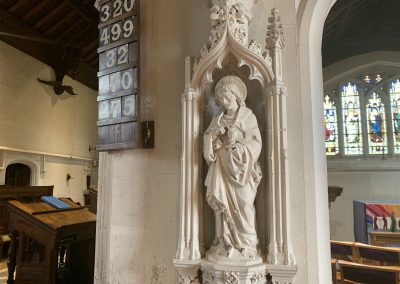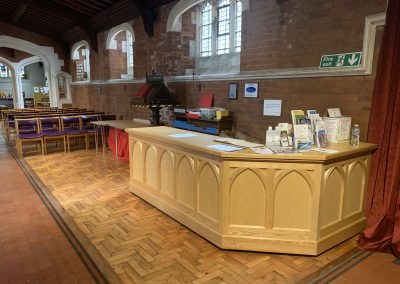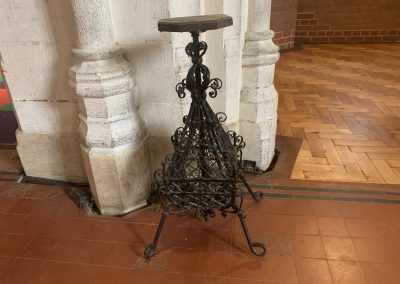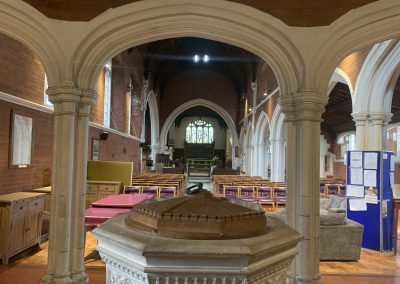Church History
The church building and its history
The story of the church of St John the Evangelist in Stansted Mountfitchet begins in the 1870s. The parish church of St Mary, a mile from the centre of the village, was then in need of extensive and expensive repairs, although it had undergone considerable restoration in 1829. There was much discussion in the parish as to the best solution; should St Mary’s be rebuilt or replaced by a new church in the village?
After nearly ten years of indecision a compromise was reached. At a meeting of the parish vestry on 26th May 1887, it was agreed that both courses should be adopted: St Mary’s should be restored and a chapel-of-ease should be built. In his parish report for the year 1886-7 the vicar, Rev’d A McKinney, noted that the decision was the result of concessions made by all interested parties. It would result in more work for the clergy and greater expense for the parish, but would, he hoped, prompt a great increase in Sunday congregations.
By the time the vestry made their decision, some fundraising for church restoration had already taken place and it was agreed that £3,000 of the money collected should be reserved for work on St Mary’s. The remainder, £726, was to be handed over to Mr F B Pulteney, who gave a site for the new church north of chapel Hill and who, with his brother and sisters, contributed approximately four fifths of the initial cost of £5,000 as a memorial to their mother. They also pledged further gifts of £100 per year, until an endowment totalling £1,500 had been established. Money for the new church was also raised at evens organised by the family. In April 1888 the Misses Pulteney, with a number of friends, performed a series of tableaux vivants in the Central Hall, which received glowing reviews in the local press, and over two days in August of the same year they held a bazaar at their home, Hargrave House, at which there were more theatricals, the band of the Honourable Artillery Company played, and £240 was raised. The ladies made their particular concern the provision in the new church of an organ, built by August Gern.
The new chapel-of-ease was to be dedicated to St John the Evangelist, sometimes called St John the Divine. The architect chosen to design it was W D Caröe, then in the early stages of his career.
Although St John’s was to be the first complete church to be built to his designs, he had already had experience of working on a major ecclesiastical building, as assistant to J L Pearson, the designer of Truro cathedral. His work was already familiar to the residents of Stansted; earlier commissions had included the rebuilding of Blythwood House, and the design of stables for Croft House in the village. In 1895 Caröe was appointed architect to both the Ecclesiastical Commissioners and the Charity Commissioners; his later work included the restoration and repair of several cathedrals and large churches, and the design of the Ecclesiastical Commissioners’ offices in Milbank, London. The main part of St John’s was built by John Shillitoe and Sons of Bury St Edmunds and had been completed by the summer of 1889. Its appearance was, however, marred by what a contemporary described as an unfinished excrescence marking the would-be position of the tower. The tower was part of the original design, but its construction may have been delayed by shortage of money. Over the next few years there were yet more attempts to raise funds; eventually most of the cost of the tower, between £1,500 and £2,000 was again met by the Pulteneys. John A Hunt was contracted to build the tower in February 1894 and it was dedicated on 29th October 1895.
The church was built chiefly of light red brick from a yard in Birchanger, with dressings of cream stone from quarries at Bath, Ketton, Casterton, and Weldon. While retaining the traditional plan of chancel, nave with south aisle and transepts, it displays Caröe’s characteristic freedom from the restrictions of the high Victorian gothic style and his enthusiasm for detail and craftsmanship; such enthusiasm was very typical of the Arts and Crafts movement of which Caröe was a follower. The exterior is much decorated, especially the tower, with its stone bands, carved figures and delicate pinnacles.
Inside, Caröe took great care to relate the parts of the church one to another; a feature very evident in the views from the south aisle through the lady chapel and chancel. Here again there are fine details; in the body of the church are carved stone niches, most filled with statues though one unfilled niche in the nave arcade remains, perhaps as evidence that funds ran out before the decoration could be completed.
In the chancel is fine woodwork, including a carved angel on the north wall, and the delicate tracery of the organ casing, surmounted by trumpeting angels. All the carving of both wood and stone was by Nathaniel Hitch, a craftsman who regularly worked with Caröe. Both inside and out, the flowing lines of some of the decoration, including the organ casing and some of the tracery in the window, presage the art nouveau style soon to become fashionable. The architect’s eye for detail even extended to the design of wrought-iron gasoliers, now converted into elegant pedestals on which to display flower arrangements.
Within the church are reminders of the two men chiefly responsible for its building. In the lady chapel a plaque commemorates F B Pulteney, who died in 1895; and in the nave hangs a watercolour by Caröe of the west end of the church, one of two illustrations he made which hung in the Royal Academy exhibitions of 1889 and 1890.
In the summer of 1889 the new church was consecrated by the bishop of St Albans who preached at the service. (Stansted was of course in the diocese of St Albans before the diocese of Chelmsford was formed at the beginning of the twentieth century.) Afterwards there was an organ recital by Mr Harrison of Birchanger. In his report on the service the vicar commented that ‘St John’s was … a beautiful structure; indeed it is one of which we may justly feel proud.’ In that year morning and afternoon services were held at both St Mary’s and St John’s; Holy Communion was celebrated at St Mary’s on the first Sunday of the month and at the great festivals and at St John’s on the first and third Sundays. In 1890 Rev’d McKinney reported that ‘our two-church scheme appears to work very well, although it was necessary in so large a parish.’ Some of the cost of employing an assistant was borne in the early years by the endowment fund set up by the Pulteney family, although its value declined in the 20th century. Payment of the income from the endowment was not unconditional, however; every year a certificate had to be sent to the Ecclesiastical Commissioners, who administered the fund, confirming that morning and either afternoon or evening services had been held at St John’s each Sunday and that at least one service had been held there on Good Friday.
Throughout its life, additions and alterations have been made to the interior of the church. In the early part of this century, they were intended chiefly to complete its furnishings and decoration. In 1902 the east window in the chancel by Burtesson and Greylls, was installed; the centre panel shows the crucifixion, with St John and Our Lady, and the side panels depict St Alban and St Augustine of Canterbury.
Two years later Caröe was commissioned to design a font, and in 1905 the vicar, Rev’d G H Oakshott, furnished the lady chapel so that it could be used for occasional services.
In 1929 the reredos, again carved by Nathaniel Hitch, was placed in the chancel, and in the same year a new east window was installed in the lady chapel. A trend towards greater informality in the use of the church building was reflected in 1934 by the removal of chairs from the north transept so that it could be made into a children’s corner. In 1939 the fiftieth anniversary of St John’s was celebrated by special services, some of them attended by clergy who had been present at the church’s consecration. Six weeks later part of the baptistry, the space under the west gallery, was dedicated as the chapel of St George, in which services of intercession were held during the years of the Second World War.
By the 1970s the church was beginning to show signs of its age; walls and floors were suffering from rising damp, roofs and gutters were in need of repair, and areas of both brick and stonework were affected by frost and moisture damage. In 1981 an appeal was launched to raise £80,000 to undertake the necessary repairs, and just as in the 1880s, fundraising became the order of the day. A flower festival was held in St John’s in 1982, and in 1984 a Stansted Festival included floral displays and exhibitions in both St Mary’s and St John’s churches, a concert, dance, and firework display. Since then the work of the appeal continued in a quieter vein, and in 1989, the year of St John’s centenary, the total needed, just over £100,000 was in sight. It is to mark the centenary, celebrated in June 1989, that this history was originally written.
Now in the twenty-first century St John’s has been the parish church of Stansted since the early nineteen-nineties when the former parish church, of St Mary became redundant, and was placed in the care of the Churches Conservation Trust. St John’s continues to be a loved and cherished building in which people are still called to worship as a community of Christ and to be a special place of prayer for all God’s children.

